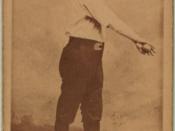The death of Gloria after being pushed down the stairs by Fred throws up the discussion of liability for Fred and Louis for murder under the Homicide Act 1957. During the course of this discussion the topics of accomplices, provocation and diminished responsibility will also be considered, especially in relation to a possible reduction from murder to voluntary manslaughter. Finally there will be a brief discussion of a possibly different outcome if Fred and Louis were just attempting to scare Gloria away rather than hurt her.
To prove murder the prosecution would have to prove that the death was caused by the defendantÃÂs act. In our case this is easy to prove, Gloria would not be dead if Fred had not pushed her down the stairs. However defendants can only be held responsible for a death where their acts are both a factual and a legal cause of the victimÃÂs death.
To prove factual causation the prosecution must prove that but for the conduct of Fred and Louis Gloria would not have died as and when she did. Also the original injury arising from Fred and LouisÃÂs conduct has to be proved to be more than a minimal cause of GloriaÃÂs death. In White the defendant gave his mother poison but before it had chance to work she died of a hearth attack, so he was not liable for her death. However, both factors should not be a problem for the prosecution to prove in our case.
Once factual causation is established the judge must direct the jury as to whether the defendantÃÂs acts are sufficient to amount in law to a cause of the victimÃÂs death. This can be proved in one or more of three options. Firstly the original injury must be an operative and significant cause of death. In R v Smith where a soldier was stabbed in a brawl and then subsequently dropped and mistreated by the doctor the court nonetheless took the view that the original wound was still an operative cause and the accused was liable for murder. In our case there should be no difficulty proving the act was an operative and significant cause of death.
The second legal causation element is that the intervening act was reasonably foreseeable, in our case this factor would not apply as there was not intervening act between GloriaÃÂs fall down the stairs and her death.
The third factor is the ÃÂthin skullÃÂ test. Where the intervening cause is some existing weakness of Gloria, Fred and Louis must take their victim as they find her. So even if Gloria died when another person may have survived the fall Fred and Louis are still liable for her death.
Therefore we can see that Fred and Louis have fulfilled the actus reas element for murder, to fulfil the mens rea it must be proved they had the malice aforethought, which has come to mean either an intention to kill or an intention to cause grievous bodily harm.
However, the defendants motives do not need to be malicious, deliberate euthanasia prompted by motives of compassion satisfies the mens rea requirement just as well as the shooting of a hated person. Also premeditation is not a necessary requirement; so long as the required intention is there, it is possible for a murder to be committed on the spur of the moment.
The test of what the defendant foresaw and intended is always a subjective one, based on what the jury believes the defendant actually foresaw and intended, and not what he should have foreseen or intended, or what anyone else might have foreseen or intended in the same situation. Direct intent applies where the accused actually wanted the result that occurs and sets out to achieve it. Oblique intention applies where the accused did not desire a particular result but in acting as he did realised it might occur.
In R v Moloney where the defendant killed his father in a gun contest it was clear he did not intend to kill his stepfather but Lord Bridge pointed out it was quite possible to intend a result which you did not actually want. Further, in R v Hancock and Shankland which concerned striking miners who threw concrete onto a taxi, Lord Scarman suggested the jury should be directed that ÃÂthe greater the probability of a consequence, the more likely it is that the consequence was foreseen and that if that consequence was foreseen the greater the probability is that that consequence was also intended.ÃÂWhere does this leave Fred and Louis in relation to mens rea? They may not have had the direct intention to kill Gloria but it should be feasible to prove that they did have the oblique intention if Lord ScarmanÃÂs words are taken into account, the probability of Gloria dying from a fall down cellar steps are quite probable, so therefore it is more likely that the death was foreseen and therefore more probable that the death was intended.
From the discussion above it is clear murder could be proved but would it apply to both Fred and Louis? Fred was responsible for pushing Gloria down the cellar stairs, would Louis be just as culpable for his act of calling Gloria into the room? Was he aware of what Fred intended to do? In regard to accomplices the person who actually commits the actus reas of an offence may not be the only person who is liable for it. If other people play a part in the crime, they too may incur liability as a secondary party.
The test of whether someone is a joint principal or a secondary party is whether they contribute to the actus reas by their own independent act, rather than simply playing a supporting role.
The key provision for indictable offences is s. 8 of the Accessories and Abettors Act 1861. This states: ÃÂWhosoever shall aid, abet, counsel or procure the commission of any indictable offence, whether the same be an offence at common law or by virtue of any Act passed or to be passed, shall be liable to be tried, indicted and punished as a principal offender.ÃÂA secondary party is a person who helps or encourages the principal offender before the offence is committed, or at the time when it is committed. By Louis calling Gloria into the kitchen by pretending that he burnt himself so that Fred could carry out the act of pushing Gloria down the stairs he is helping Fred before the act is committed. The extent of each partyÃÂs involvement in a crime will usually be taken into account for sentencing purposes, the exception here being where the penalty is fixed as in the case of murder, but under s. 8 helping or encouraging someone else to commit a crime can attract the same punishment as actually committing the crime.
The implications of this principle can be seen in the controversial case of R v Craig and Bentley where the accomplice, Bentley, is alleged to have said ÃÂlet him have itÃÂ to Craig who held a gun who then shot the policeman. Both were convicted of murder and Bentley was hanged.
Looking at the actions of aiding, abetting, counselling or procuring it is clear Louis did aid Fred by providing some help by calling Gloria into the room. It would not be possible to prove Louis abetted Fred in that we cannot prove Louis encouraged Fred to commit the crime at the moment of the act, mere presence is not enough as seen in R v Clarkson where soldiers who stood and watched a rape where found not to be abetting the rapist.
In regard to counselling, the principal, Fred, must be aware that he has the encouragement or approval of the secondary party, Louis, to commit the offence. The discussion Fred and Louis had prior to the act to ÃÂmake Gloria go awayÃÂ could easily been seen to fit this criteria. For procuring Louis could also be said to be liable, as he was part of the cause and reason for bringing the act about.
The mens rea to be liable as a secondary party must also be proved. It must be shown that the defendant knew that acts and circumstances constituting a crime would exist. The level of mens rea required is low, all that is needed is that the person acted voluntarily, so that Louis intended to do what he did, rather than he intended its effect on the principal Fred. The secondary party does not have to want the crime to be committed to still be liable, as seen in the case of DPP for Northern Ireland v Lynch where a man was ordered to drive to a place where a policeman would be killed.
For a joint enterprise the Court of Appeal in Peters and Parfit said the defendants must have a common purpose or intention. In the case of R v OÃÂBrien it was decided that it only had to be proved the accomplice knew that in the course of committing the agreed crime the principal offender might act with an intent to kill. It was not necessary for him to know that the principal offender would act with such intent.
However, if it could be proved that there are mitigating circumstances for the murder of Gloria, Fred and Louis could use the partial defences available to reduce liability to voluntary manslaughter. They would still be charged with murder but could put their defence of provocation and diminished responsibility during the trial. Successful pleading of one of these defences means that on conviction the sentences could be anything from life imprisonment to an absolute discharge.
Provocation is covered by s. 3 of the Homicide Act 1957 and three elements have to be proved: provocative conduct, that the provocation made the defendant lose their self control; and that a reasonable person would have been so provoked.
For provocative conduct, provocation may be ÃÂby things done or by things said or by both togetherÃÂ, so words alone may suffice. The provocative act need not be illegal or even wrongful, in the case of Doughty the persistent crying of a baby could be held to amount to provocation. In our circumstance the fact that the brothers were to be moved to a residential home against their wishes because of GloriaÃÂs recent marriage to Jake could definitely be seen as necessary provocation.
For the subjective test of loss of self-control it must be due to a loss of temper. In R v Duffy the loss of self-control must be ÃÂsudden and temporaryÃÂ. This controversial qualification makes it unlikely to be the case for revenge murder since the conscious formation of a desire for revenge means a person had time to thinkÃÂ. This revenge motive would seem to fit our case better as Fred and Louis had discussed making Gloria go away and the final act was not a immediate reaction upon hearing the news or their move to a residential home. Courts have become more lenient where there has been a time lapse as seen in the cases of R v Pearson and Ahluwalia but a cooling off period is not a matter of law but a piece of evidence which the jury may use. Therefore Fred and Louis would have to rely on cumulative provocation and see if the jury would agree as the classic subjective test of loss of self-control would not apply.
Also for the defence to succeed it must be proved that the response was not out of all proportion to the provocation, the ÃÂreasonable personÃÂ test. The central question has been whether a reasonable person can be given particular characteristics of the defendant in assessing whether they would have reacted in the way the defendant did. In a string of cases this was found not to be so, but the leading case is now the House of LordÃÂs judgement of R v Smith where two alcoholics argued and Smith killed McCullagh. SmithÃÂs defence of depression was allowed as the characteristics of the defendant beyond simply his age or sex could be taken into account. Therefore Fred and louisÃÂs educationally subnormal condition could be taken into account and left to the jury to decide if their actions were reasonable in the face of the provocation.
The defence of diminished responsibility under s. 2 of the Homicide Act 1957 was introduced because of problems with the very narrow definition of insanity under the MÃÂNaughten Rules. The wider interpretation covers an abnormality of the mind, a state of mind which a reasonable person would consider abnormal. In R v Byrne where an appeal was allowed to a man who strangled a woman and claimed a defence of irresistible sexual impulses.
The cause of the abnormality must arise from a condition of arrested or retarded development of mind which could be applied to Fred and Louis in their educationally subnormal state. The effect of the abnormality must be such that it substantially impairs the defendant's mental responsibility for his acts or omissions with regard to the killing which again would encompass Fred and Louis.
Therefore we can conclude by saying that Fred and Louis would be liable for the murder for Gloria but they would be able to plead the partial defences of provocation and diminished responsibility which on conviction would leave their sentence to the discretion of the judge.
However, if Fred and Louis had agreed that they were definitely not trying to hurt Gloria but to ÃÂscare her awayÃÂ we would have to consider their liability for involuntary manslaughter as they had the actus reas for murder but not the mens rea. In this scenario they would be liable for constructive manslaughter where death is caused by an act, not an omission.
To prove constructive manslaughter the act which causes death must be a criminal offence, in our case Fred pushing Gloria down the stairs would be classed as battery by s. 39 of the Criminal Justice Act 1988. The actus reas of battery being the unlawful application of force on another.
Additionally it must be proved that the act was dangerous. In R v Church where a woman died from drowning after an fight the Court of Appeal held that an act could be considered dangerous if there was an objective risk of some harm resulting from it, this would be easy for the prosecution to prove in our case. Especially as this is a purely subjective test so it does not matter that the accused did not realise that there was a risk of harm from his actions. Also in R v Ball where Ball shot his neighbour with live rounds instead of the blank rounds he thought heÃÂd loaded, it was decided that whether an act was dangerous or not should be decided on a reasonable personÃÂs assessment of the facts, not on what the defendant knew.
Finally the unlawful and dangerous act must also cause the death, which it does in our case. Meanwhile the mens rea required for constructive manslaughter is that of the crime constituting the unlawful act which is the battery against Gloria. For battery it can be intention or recklessness as to the application of unlawful force which again would be easily proved against the accused in our case to give a final charge of involuntary manslaughter against Fred and Louis if they could argue successfully that they had intended to just scare Gloria away.
BibliographyCriminal Law, Nicola Padfield - 2nd EditionCriminal Law, Catherine Elliott and Frances Quinn - 4th Edition150 Leading Cases Criminal Law - 1st Edition
![[Portrait of Louis Armstrong and Jack Teagarden, between 1938 and 1948] (LOC)](https://s.writework.com/uploads/4/45429/portrait-louis-armstrong-and-jack-teagarden-between-1938-an-thumb.jpg)
![[Slim Sallee & Jack Bliss?, St. Louis NL (baseball)] (LOC)](https://s.writework.com/uploads/3/39861/slim-sallee-jack-bliss-st-louis-nl-baseball-loc-thumb.jpg)



